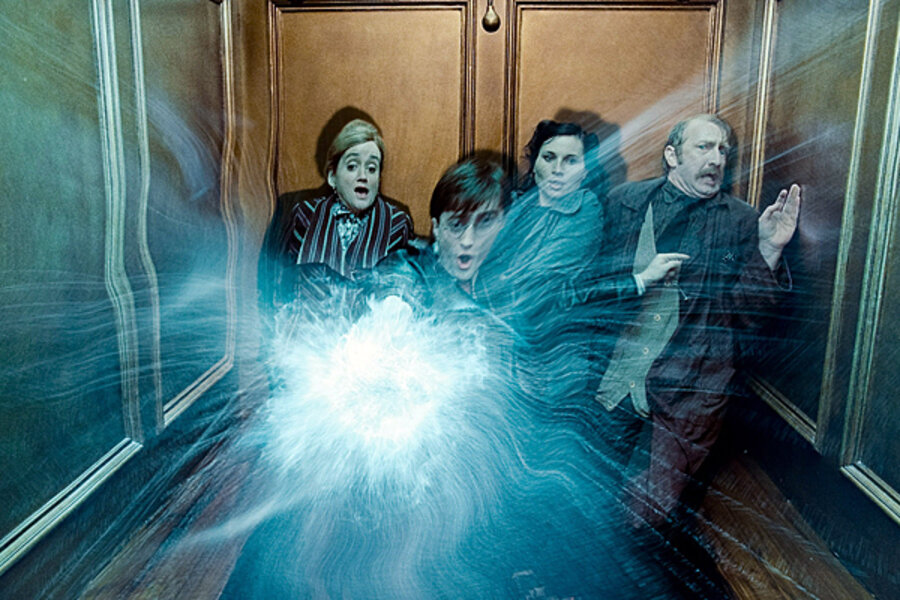Midnight madness: 'Deathly Hallows, Part 1' sets a Harry Potter record
Loading...
| Los Angeles
The first half of the Harry vs. Lord Voldemort showdown, "Harry Potter and the Deathly Hallows, Part 1," summoned a $24 million box office at some 3,700 midnight screenings nationwide – a record midnight-screening take for the Potter franchise, and one that has been surpassed only by the last two Twilight films.
From New York to Los Angeles and Delaware, Ohio to Walnut Creek, Calif., bespectacled and spell-chanting fans of J.K. Rowling’s saga of “the boy who lived” turned out early Friday to bond in the dead of night, clad in the colors of the rival Gryffindor and Slytherin houses.
Many of these faux-butter-beer-quaffing denizens of the late-night event knew full well they would be expected at their jobs Friday morning.
Kristina Moy, a recent graduate of the University of Massachusetts at Amherst who is also an (unpaid) staff member of the International Quidditch Association, turned up somewhat bleary-eyed at 10 a.m. for her customer service job at a digital print shop in Hadley, Mass. She says she can't wait to get off work at 5, so she can gather with friends to talk about the film.
The day's sleepiness aside, she says, there was nothing like the group event. "It just brought all kinds of people together," she says. The 22-year-old adds that she attended with her quidditch team, "dressed in our team colors, maroon and white, which is sort of ‘Gryffindory' I guess," referring to Harry's house, one of four at the Hogwarts School for Witchcraft and Wizardry.
Flash mob in Manhattan
Just a few hours south, Jonathon Rosenthal, head of the largest Harry Potter fan clubs in the country, says his Manhattan event began with a bang in Columbus Circle. "
We conjured up a flash mob," he says, one chock full of wildly costumed characters from the seven-book series, including the half-giant, half-wizard Hagrid and several folks from the dark side, among them Lord Voldemort, Bellatrix Lestrange, and the pivotal Severus Snape. The group proceeded down Broadway into the theater, where they entered early enough to party on as a group before the film began.
Many theaters across the nation allowed the devotees early entrance. At the 94-year-old Strand in Delaware, Ohio, some 300 longtime patrons enjoyed singing from theater staff, who were joined by "representatives of various Ohio Wesleyan University Arts Majors, to serenade a young Harry Potter enthusiast who turned 11 years old at the strike of midnight," says theater manager Kara Long.
Midnight showings have become a staple of modern blockbuster moviegoing, says Fandango spokesman Harry Medved, who movie-hopped between two midnight showings, taking notes on the mood of the crowds.
"This is a bittersweet event for many longtime fans," he says pointing out that the huge number of college students at the showings all grew up with this franchise. "This is their coming-of-age as they watch Harry, Hermione, and Ron leave the safety of school and go out into the world to face the adult forces trying to destroy him and his friends. "But, he adds, "it also signals the beginning of the end for the movies."
The "witching hour" is a natural for this cohort, says M. E. Warlick, director of the School of Art and Art History at the University of Denver, where she also teaches a class on Harry Potter and the traditions of Western esotericism, such as alchemy, magic, witchcraft, and herbal medicine.
Many in this age group are naturally night owls, and the added bonus of being able to push the daily world aside in favor of a loved story makes midnight gatherings "a natural for Harry Potter fans," Ms. Warlick says.
Staple of blockbuster marketing
The midnight events are a huge boon to small theaters some of which make more on these one-time events than they do in an entire season, points out Steve Felperin, president of Theatre Service Network, an Illinois-based firm devoted to serving independent theaters. Not every film is a candidate for the midnight event; in fact few are. But, he says, those who offer them find that it doesn't detract from regular ticket sales.
People want the feeling of being first that they get from the early viewing, but, he adds, "typically, most midnight moviegoers also turn up again sometimes for three and four more viewings."
What qualifies for the midnight movie treatment? "Usually, the studios must be expecting it to make at least $200 million," he says. Theaters "don't do it for movies making less than that."





